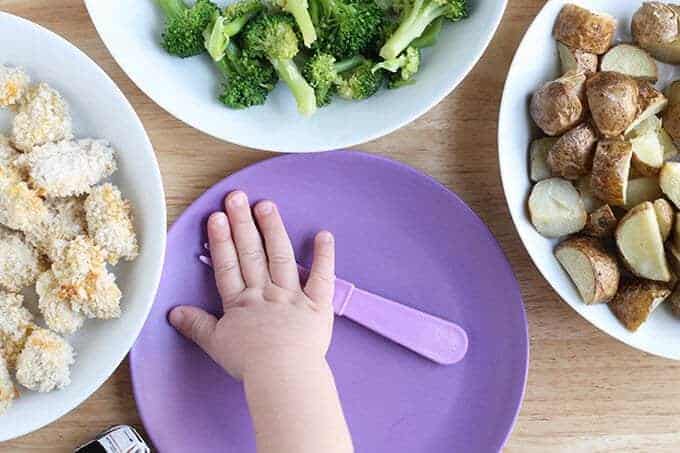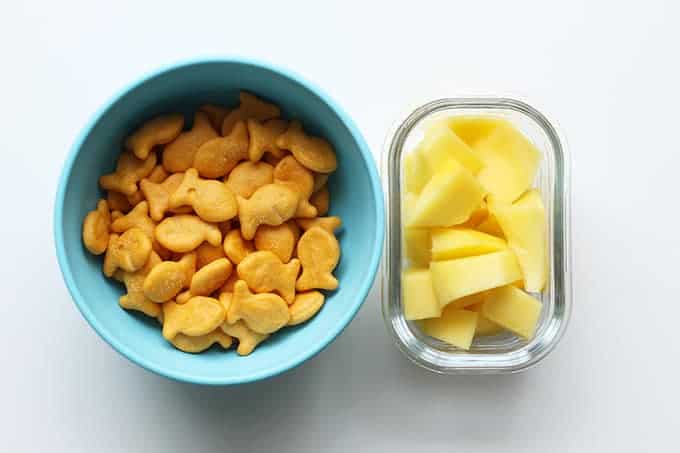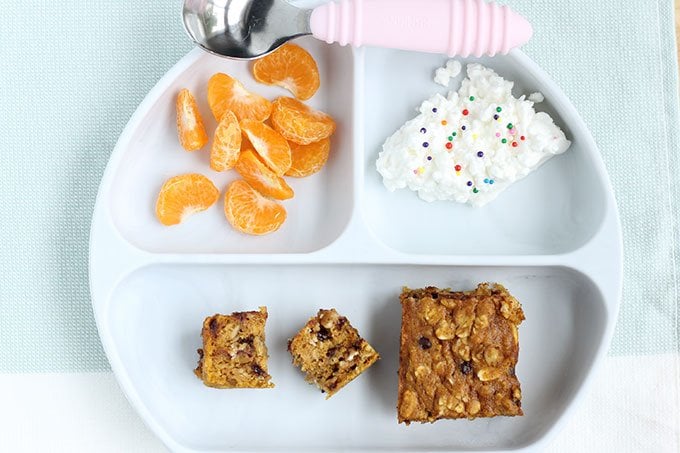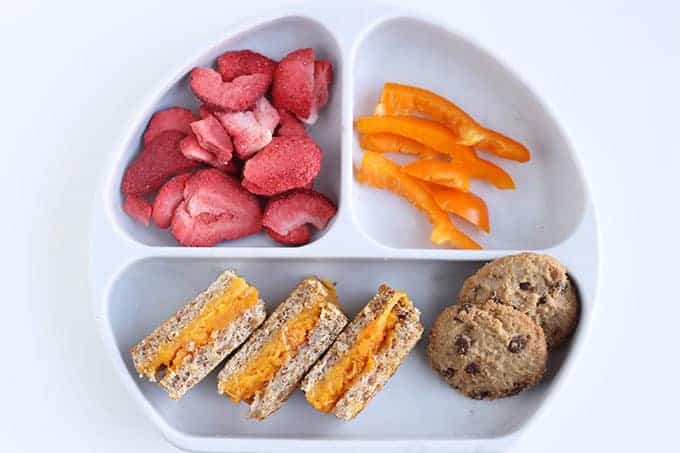There’s a feeding method known as the Division of Responsibility that can drastically improve mealtime battles and picky eating in kids. We’re going to explain it all step-by-step to help you improve your own family meals with less work than you might expect. (Really!)
 The Division of Responsibility
The Division of Responsibility
The Division of Responsibility in Feeding is an evidence-based approach to feeding kids that aims to allow parents to set boundaries through setting mealtimes and the specific foods that are in each meal, but it also gives kids the chance to learn to trust their own hunger and fullness cues. This is not a diet or a set of rules, but a guiding principal that clearly sets out what parents and kids are each responsible for at mealtimes.
The goal of using this approach is happier, less stressful mealtimes where the parents and kids can independently enjoy their food without one needing to push or prod additional bites or clean plates.
It also helps to foster intuitive eating as it allows the kids to decide how much food to eat on their own. The goal here is not to “get the kids to eat”, but to set a foundation for happier meals for the whole family—and foster body autonomy by letting the kids control their intake within the boundaries that we set.
Table of Contents
- The Division of Responsibility
- Where did this method come from?
- Why should I try it?
- How the Division of Responsibility Works Step-by-Step
- How Family-Style Meals Can Help
- Can I do DOR if I'm not doing family style meals?
- Frequently Asked Questions
- How You Know You're Doing it Right
- Additional Resources
- Listen for More
Where did this method come from?
This method was pioneered by the feeding therapist and psychotherapist Ellyn Satter. She’s since trained many other feeding therapists to use this approach and for those of us who spend time thinking and talking about picky eating, it is such a gigantic help when it comes to lessening the potential challenges of both of those topics.
TIP: The approach can also be used to help kids learn how to eat, to help reset food habits that are causing stress, and to recalibrate the balance of power during mealtimes. This is a great tool if meals seem like they have turned into a battle of wills.
Why should I try it?
If you feel any of these statements is true, even sometimes, and you’re looking for a way to change things, the approach is definitely worth a try.
- My child refuses to eat the dinner I make for the rest of the family and holds out for food he prefers. (I usually give it to him because I just want him to eat!)
- My child likes to graze all day and is never hungry for meals.
- I’m concerned that my child isn’t eating enough.
- I’m concerned that my child is eating too much.
- I’m worried that my child is sneaking food or lying about what they’re actually eating.
- I’m stressed out about mealtimes.
- I don’t know how to serve meals that everyone in the family will eat.
- My child is super picky and only wants to eat his favorite foods.
TIP: It’s a very broad approach that can help with almost any feeding issue (apart from serious medical ones—those require the help of a pediatrician or individual feeding therapist!).
 How the Division of Responsibility Works Step-by-Step
How the Division of Responsibility Works Step-by-Step
Here’s a look at how the DOR works step-by-step so you know exactly how to do it.
- PARENT’S JOB: You are encouraged to take leadership with the what, when, and where of feeding.
- KID’S JOB: To decide which of the foods on offer and how much to eat.
This means that parents:
- Choose which foods to serve and prepare it, doing your best to make sure it’s easy to eat and yummy.
- Stick to regular meals and snacks at predictable and appropriate times.
- Help to make eating times pleasant.
- Show kids how to behave at family meals by your own example.
- Model eating by being there to show kids how to eat certain foods they may not have seen.
- Understand that children don’t have a deep well of food memories and may be wary of trying new foods.
- Understand that children will have natural likes and dislikes.
- Understand that each body is different and that your child has the right to grow into theirs. And that we don’t aim to make bodies larger or smaller with food unless there’s a medical issue at play.
- Talk about what the food is and what it might taste like, but aim to avoid pressuring the kids to take a certain amount of bites.
- Avoid using food as a reward for good or preferred behavior.
And the kids:
- Are free to choose the foods they want to eat from what you’ve served.
- Are free to eat the amount of food that they want (assuming everyone is sharing and you actually have more food).
- Learn to share the food on offer before getting seconds.
- See parents and older siblings modeling good mealtime behavior and learn to follow suit.
- Are free to be done eating when they say they’re full.
- Learn to accept that we sometimes have to wait until the next meal or snack time to eat.
- Learn to accept that not every mealtime will be a favorite.
TIP: This isn’t meant to be rigid or cause any battles, so if that is happening, take a deep breath and look at the context of where the stress and anxiety is coming from. What else is going on in life? There are times when feeding a family may be easier than others.
 How Family-Style Meals Can Help
How Family-Style Meals Can Help
An approach that can greatly improve the success of using this feeding method is to serve meals family style. This way, all of the food is on the table so everyone can see what’s on offer. And everyone has an equal chance to serve themselves exactly what they want on their plates.
Put the food on the table—or on the counter if you don’t have room at the table—and let the kids decide what to put on their plates. The kids can even actually put the food on their plates, even toddlers. (My two year old routinely does this and while sometimes she missed her plate, it’s so empowering!)
Use the principal of sharing to ensure that everyone gets some of what they want—so a child can’t take the entire bowl of corn if no one else has had any yet—and talk about what foods taste like and are similar to if something is new.
TIP: Read more on Family Style Meals here.
Can I do DOR if I’m not doing family style meals?
Yes. Doing family style meals is not a requirement of this approach, though it can be a useful option in the mix. If you will be plating the food for the kids, I recommend starting with very small portions to avoid wasting food or overwhelming the kids, then allow more as requested and as you have after everyone is sharing.
 Frequently Asked Questions
Frequently Asked Questions
Here are some questions that many parents have about using the Division of Responsibility in Feeding with their kids:
What if my child doesn’t want the foods I’ve served?
A phrase I like to use is “not every meal will be your favorite but you can still eat it”. This isn’t forcing food, but is reminding kids that we all have favorite foods. Allow the kids to serve themselves from the foods they want and don’t insist that they take a certain amount of anything. That should help, especially if you are consistent.
Intake naturally varies and just because a child eats more some days and less others doesn’t mean they are “picky”. That’s 100% normal.
What if my child only wants one of the foods I’ve served?
That will likely happen some times and it is okay in the overall scheme of things. Look at their intake over a broader span of time, not just each meal, and it will be more varied. If they are stuck on the food being not what they want, you can change the subject to get them to talk about something from their day.
This can help take focus away from the food so they can relax and enjoy the time together. Then, be sure to let them have their fill of the foods they do want, assuming everyone is sharing and you actually have more. (Yes, some meals will be more of one food group than another.)
TIP: Read more about Normal Picky Eating.
What if my child says they are hungry between mealtimes?
This can be hard since often when kids say they are hungry, they’re really bored, tired, or wanting attention. I use the phrase “I hear that you’re hungry and dinner is almost ready. Can you go do XX until I have it on the table?”. You can also decide to institute a regular appetizer if something like this happens routinely (kids are often super hungry for dinner!) but I recommend that you still decide what the food is—we regularly have cut up fruit or veggies available to help tide kids over until dinnertime.
Also look at the context. Did your child skip snack or not eat much? They may actually be hungry. Are they really asking for attention after a long day and they want you to focus on them? Try to assess using the context of the moment and be responsive to your child.
How do I cook a meal that everyone will like?
Aim to include 1-2 foods that your child usually likes, even if that means a simple side of fruit, and understand they won’t love every meal. It’s okay! There’s no way to serve 100% of meals that everyone will like, so accept that you will sometimes make meals that they like, that are new, that you have no idea whether or not they will eat.
The beauty of this system is that without pressure, kids very often try things you don’t expect them to since there aren’t any power dynamics at play.
If you’re trying to do Division of Responsibility and you’re feeling stressed or you feel like something isn’t working right, be sure to check in with the additional info on the Ellyn Satter website. There are so many good resources there!
What if my child only eats one food group?
This is a common concern, especially with the category of carbs. Yes, kids naturally gravitate towards foods that are more comfortable to them and that is normal. (Also, kids need carbs!) It’s normal for kids in the toddler years to eat a more narrow set of foods and to expand a bit more as they hit the elementary years.
If you can zoom out on their intake and worry less about each specific meal, that can help your perspective.
Kids aren’t robots and they don’t eat like a chart says they will. Some meals are more of one food group than another, but it usually looks more balanced over the course of a whole week.
What if my child refuses to try anything new?
Kids don’t have many years of eating under their belts and so it is understandably intimidating to try something when they have no idea how it will taste. Try talking about what the food is by comparing it to foods they are more familiar with, offer a dip you know they like, allow time and repeated exposures in the process of learning to like foods, show them that you like it, make sure it’s easy for them to eat, and have patience.
Learning to eat is a process and it can take longer for some kids than others. The phase of neophobia, or fear of new foods, is real.
(I like to consider how I ate as a child and how we expect our kids to eat now. I never had a smoothie until I was in college and didn’t have kale until I was in my mid-20s. Our expectations have really changed a lot!)
TIP: Learn about what to do when the kids won’t eat here.

How You Know You’re Doing it Right
I will start by saying that as someone who’s been using this method for over 5 years, there will be good days and less-good days because…kids! And food is often highly charged and emotional for everyone, no matter how hard you try to stay neutral. BUT, by allowing the kids to trust their hunger and eat the foods they want to eat without pressure, you can drastically improve the experience of mealtimes.
Keep these things in mind:
- Kids won’t always eat every food group at every meal.
- Kids will naturally be hungrier some days and meals and less so at others.
- There is no “right” portion for everyone, no matter what labels and packages say.
- Little kids are naturally able to regulate their own hunger (but they can lose that ability if we push and prod them to eat or not eat too much).
- This method is incredibly freeing for parents because rather than assuming that your kid is picky, this is your new normal: If my child isn’t eating, they must not be hungry for food.
- Know that if a child doesn’t eat much at one meal, they have another opportunity that’s not too far away at the next scheduled eating time.
- By allowing the kids to regulate their own hunger and fullness, it frees you up to do the same at meals so you can enjoy your own food.
- Talking about things other than food at mealtimes can be a huge help too. We love telling jokes at our table—it puts the focus on being together and laughing and helps the kids enjoy our time at the table even if they don’t love a certain food.
- The goal is not to get the kids to eat the exact foods in the exact amounts that we think is right—but less stressful meals and setting a foundation for raising kids who can learn to eat confidently when they’re at home and out in the world as they grow.
Additional Resources
It can be hard to navigate this approach if you are fearful of certain food groups or are trying to prevent the kids from having their favorite foods. If you feel worried about the foods your kids like, food groups like sugar, or get emotional when feeding your kids, I recommend reading books including The Eating Instinct, Intuitive Eating, Anti-Diet, and What We Don’t Talk About When We Talk About Fat.
TIP: My ebook How to Relax about Picky Eating goes in depth on all of these issues too.
Listen for More
We talked through DOR with Katja Rowell, MD, on a past episode of the Comfort Food podcast to give more nuance on how to use this feeding approach in real life. Katja is the co-author of the book, Helping Your Child with Extreme Picky Eating, which is the one I always recommend to families who are totally in the weeds with their kids eating. It’s relatable and easy to read and is a great resource to refer to whenever issues arise.
You can download this episode from iTunes, Stitcher, Google Play, TuneIn Radio, or wherever else you get your podcasts. or listen to it here!
NOTE: This post is not meant to be a substitute for medical advice. Please reach out to a care provider or a feeding therapist in the case of serious health or feeding issues.



















I like this idea but at what “age” would DOR start to be realistic? Asking as a mom of a 15 month old kiddo.
The last multiple months have been very hard to get him to eat, can I trust a 13 mo old that he will “eat enough”, or a 14 mo old?
Sometimes, even at this 15 mo old stage I don’t know if I can assume that my little boy will take responsibility of filling up his tummy. I’m so worried he’ll go hungry that after mealtime at the table I will often let him play while I try to get a few more bites into him (which sometimes works).
Two things that can help with this age: Look at if they are on their own growth curve, if they are growing, gaining weight, and meeting their milestones at each checkup. If those things are not happening, you can talk to your pediatrician or a feeding therapist. And then know that appetite often decreases in this age group specifically because growth in the 1 year old year decreases in comparison to the rapid growth in babyhood. So it’s possible they are eating enough for themselves right now, but it may seem like not enough since it is less than it used to be. I hope that helps!
Hi Amy, I love this method and we’ve been practicing it for a while now. However, we are currently experiencing a power struggle over the end of meal time. Once the end of the meal has come (and my 3 year old is clearly done, has been off doing something else and not come back to the table for any bites), I go to put it away and my child starts throwing a tantrum that he’s still eating. How would you recommend to handle this? It’s especially prevelant when we have something to do afterwards, whether that’s leaving the house, after dinner bath, or even today our plan was to make cookies after lunch. I’ve been setting a timer but that doesn’t feel good or intuitive and doesn’t prevent the meltdown.
How do you handle dessert with this method?
There are options: You can put a serving of dessert out with dinner and that is the part you decide and then the child decides if they’d like to eat it. You could have a time for dessert after dinner as a regular part of the schedule and have options for the child to choose from. We’ve done both over time and it may depend on the age and personality of the child to some extent.
Hi,
I started DOR 2 days ago. I was previously making a separate food for my 5 yo. He is not happy with this change. Last night he ate nothing and tonight he cried, but did eat the apple sauce and yogurt. He just keeps asking for one of his safe foods. Do I just stay the course? I’m sticking to your phrases but it’s breaking my heart.
There’s no rule that says you can’t include his safe foods in meals and in fact, that is encouraged. The goal is to make meals that include some or at least one food you think they’re likely to eat, which often includes one of their safe foods. So by all means, work those in:) Do what’s best for your child, always.
Hi there! We’ve been using DOR for a long time, but recently we’ve run into my kiddo overeating food. Meaning they have been eating too much and then their tummy hurts. The first few times we’ve just talked about pausing between food etc, but they’re continuing to eat too much. I’m not sure how best to go forward for a DOR perspective; any ideas?
I think some questions to consider might be: Is there a possibility they’re feeling restricted or unable to have enough foods at other times of the day that might be causing this? Is there any sort of dynamic at the table that might be causing them to feel like they won’t get their share of the foods they prefer? Would a suggestion that you could put some aside for their breakfast or lunch the next day help? Is there a possibility that the stomachache is from something else (like anxiety or worry)? It is very hard to decide how much food another person eats, so one might say that it’s not actually your job to prevent tummy aches, but to do what you’re doing with the structure of the meal and giving them options. Then that specific outcome would be up to the child. I don’t think there’s a perfect solution to this or that any two families might handle it the same, but I will say that saving leftovers for breakfast has been a helpful option in our house with this at times. If that’s not helpful, I can also ask a feeding therapist friend, just let me know!
Hi Amy, thank you for this post. My son has a handful of safe foods that he eats, mainly any pasta, white bread with chocolate spread, cheese, banana, fish dippers and cashew butter, crackers and butter. How am I meant to serve family meals with some foods that I know he will eat. There’s not enough on his list, for me to be able to rotate.I’m not sure how start. I can keep serving pasta with everything 🙈
Hi- I would make a list of every single food he eats, including different types of the same food (like pasta shapes) and see what of those foods you might be able to incorporate into dinners. You could have him help you if he’s old enough to be verbal. I suggest that since the actual list may be a little longer than you think it is when you write it all out. From the list you gave, you could do pasta, bread, cheese, banana, crackers, fish dippers as five separate meal components. Things like crackers, bread, and pasta are so basic that they could in theory be paired with a lot of things.
Great advice!
Do you have a printable version??
I don’t have a separate printable version, sorry!
Hello! Thank you for posting about this & explaining it so thoroughly. I have decided to try this approach with my 6 year old as I am just tired of the same conversations and tired of making meals that go untouched.
My question is – can you make a printable document with your most important parts on this method? Something I can hang on the fridge…🥰
Also – I’d really love something to print out and read over with my kids. I think involving them in this change that way would be helpful!
Thank you! ♥️
Mary Alice
Good idea, I’ll try to work on that!
What if the child doesn’t eat enough at dinner because she didn’t like the food and, an hour later, starts asking for cereals or crackers because she says is hungry and starts crying? She is tired, hungry but it’s also bed time…
We have one boring bedtime snack option that is always the same (ours is a banana) and the kids have that option regardless of what they ate or didn’t eat. It takes out the negotiation since it’s always the same option and it gives them something to eat if they need it. It could be another food that they will eat if they’re hungry but isn’t their favorite and isn’t a food they’d likely skip dinner for.
Thank you for this post!! Kind of takes a load off my mind.
I am so glad!
Do you recommend having a snack time after dinner?
I think that it can be an option if it helps reassure you that the kids had enough to eat before going to bed. In our house, we have a banana option if the kids ask for something before bed (but I don’t offer it—this is only if they ask). It can help if that food option is boring so it doesn’t incentivize skipping dinner. If the kids regularly say they’re hungry before bed, you can look back at dinners to make sure they have enough options to fill up on. Also, they make actually be hungry if there’s a decent chunk of time between dinner and bedtime.
Very thorough post. I’m very new to this. What advice do you give if they don’t eat dinner. You know they are hungry but then ask for food later once they leave the table Give them the leftovers they didn’t eat?
We do a very simple bedtime snack option that is boring and not a favorite food so as to not incentivize skipping dinner. I Most times I say “if you are hungry, you can have a banana or be hungry for breakfast”. You could also offer what they didn’t eat from dinner. More bedtime snack options here: https://www.yummytoddlerfood.com/bedtime-snacks/